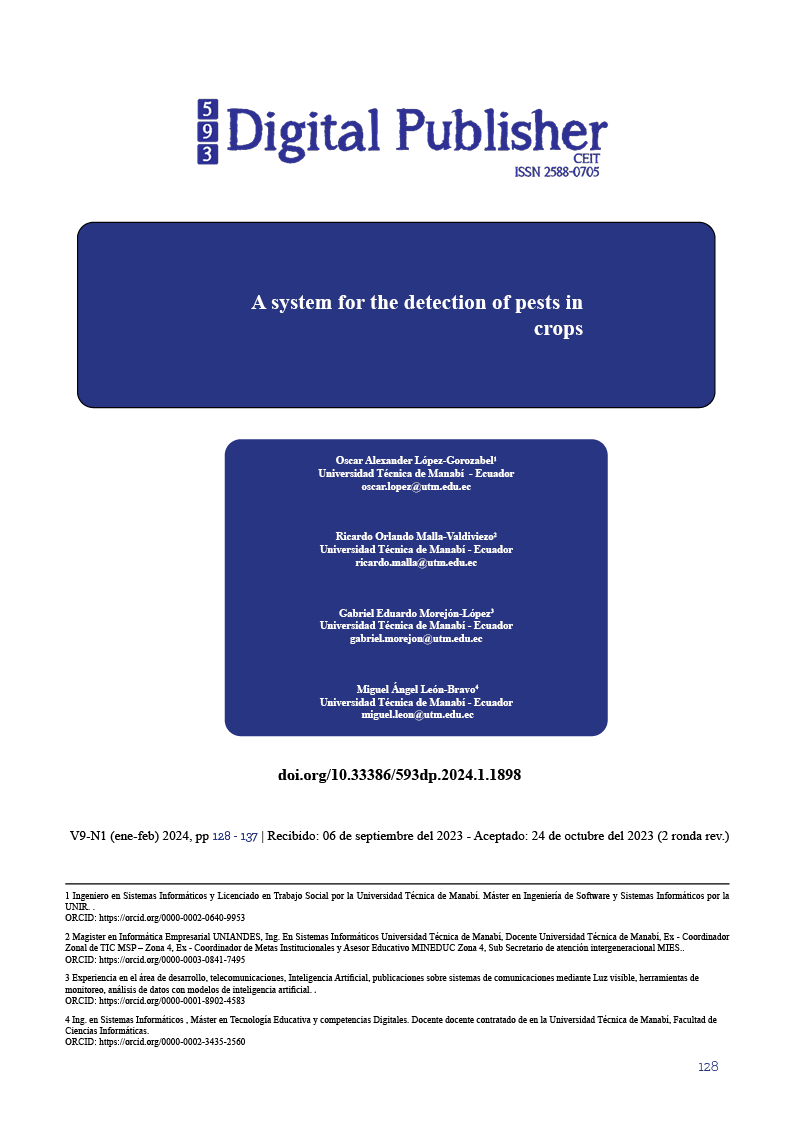A System for the Detection of Pests in Crops
Main Article Content
Abstract
The present investigation proposes the construction of a web application destined to the detection of pests, in its first phase the detection of the whitefly plague has been proposed, one of the most recurrent in the Manabí crops, mainly affecting the cultivation of plants such as tomato, pepper, cabbage and cucurbits such as pumpkin, cucumber and leafy vegetables such as lettuce or parsley. This project seeks to become a crop monitoring agent, acting automatically and effectively in the detection of pests through image processing, for which various algorithms supported by the ImageAI library were developed, with which it was possible to create, train and test a detection model. Regarding the operation of the web application, the user will be able to create an account and once logged in will be able to access the capture module, where they will be able to take or upload a photo for their respective analysis.
This research is based on the bibliographic and analytical method, in addition the information is from reliable sources, such as: IEEE, Dialnet, ACM, Google Scholar, Institutional Repositories. For the development of the web application, the Python programming language was used for the Backend and technologies such as HTML, W3Css and JavaScript for the Frontend. Subsequently, MySQL was used to create the database.
The framework used for the development of the application was Scrum, due to the versatility of its methodology. Finally, as a result of this project, the first version of functional software is obtained, with aspirations to improve in future versions.
Downloads
Article Details

This work is licensed under a Creative Commons Attribution-NonCommercial-ShareAlike 4.0 International License.
1. Derechos de autor
Las obras que se publican en 593 Digital Publisher CEIT están sujetas a los siguientes términos:
1.1. 593 Digital Publisher CEIT, conserva los derechos patrimoniales (copyright) de las obras publicadas, favorece y permite la reutilización de las mismas bajo la licencia Licencia Creative Commons 4.0 de Reconocimiento-NoComercial-CompartirIgual 4.0, por lo cual se pueden copiar, usar, difundir, transmitir y exponer públicamente, siempre que:
1.1.a. Se cite la autoría y fuente original de su publicación (revista, editorial, URL).
1.1.b. No se usen para fines comerciales u onerosos.
1.1.c. Se mencione la existencia y especificaciones de esta licencia de uso.
References
Andrade, J. (2018). Aplicación móvil para la detección y tratamiento de daños de los cultivos de la parroquia Taura del cantón Durán, mediante el uso de software de análisis de imagen basado en técnicas de Machine Learning. http://201.159.223.180/bitstream/3317/11769/1/T-UCSG-PRE-ART-IPM-150.pdf
De Martí, S. P. (2018). AGRICULTURA DE PRECISIÓN y PROTECCIÓN DE CULTIVOS. Revista de ingeniería, 47, 10-19. https://doi.org/10.16924/revinge.47.3
Flores, A. (2021). Lista de las mejores librerías de Python para el 2022. crehana.com. https://www.crehana.com/ec/blog/desarrollo-web/librerias-python/
Fuentes, M., & Medina, W. (2021). Diseño de un modelo predictivo-asistencial de pacientes infectados por Covid-19, mediante un modelo supervisado de Machine Learning basado en criterios de derivación hospitalaria o ambulatoria. Repositorio Universidad de Guayaquil. http://repositorio.ug.edu.ec/bitstream/redug/52650/1/B-CISC-PTG-1901-2021%20Fuentes%20Marmolejo%20Melina%20Daniela%20-%20Medina%20Parra%20Wilmer%20David.pdf
Landau, E. C., Guimaraes, D., & Hirsch, A. (2014). Uso de sistema de informaciones geográficas para espacialización de datos del área de producción agrícola. ResearchGate. https://www.researchgate.net/publication/280098376_Uso_de_Sistema_de_Informaciones_Geograficas_para_espacializacion_de_datos_del_area_de_produccion_agricola
Llamas, L., & Sulé, M. (2021). Tecnología en la agricultura. Innovación como método de evolución agrícola. Universidad de León. https://buleria.unileon.es/handle/10612/13619
Magaña, J. B. (2015). DETECCIÓN DE OBJETOS EN IMÁGENES UTILIZANDO OPENCV PARA RASPBERRY. ResearchGate. https://www.researchgate.net/publication/316282519_DETECCION_DE_OBJETOS_EN_IMAGENES_UTILIZANDO_OPENCV_PARA_RASPBERRY
Maniyath, S. R., Vinod, P., M, N., R, P., N, P. B., N, S., & Hebbar, R. (2018). Plant Disease Detection Using Machine Learning. International Conference on Design Innovations for 3Cs Compute Communicate Control (ICDI3C), 41-45. https://doi.org/10.1109/icdi3c.2018.00017
Marín, R. (2020). ¿Qué es OpenCV? Instalación en Python y ejemplos básicos. Canal Informática y TICS. https://revistadigital.inesem.es/informatica-y-tics/opencv
Nuñez, O., Figueroa, T., & De Jesús, A. (2015). Monitorización de cultivos utilizando drones. Docplayer.es. https://docplayer.es/13303546-Monitorizacion-de-cultivos-utilizando-drones-clave-del-proyecto-cin2015a20121.html
Olafenwa, M. (2022). ImageAI: A Python library built to empower developers to build applications and systems with self-contained computer vision capabilities [Software]. En GitHub (2.1.6). https://github.com/OlafenwaMoses/ImageAI
Otálora, P., Sánchez, J., Fernández, F., & Soria, M. B. (2021). Herramienta gráfica para la caracterización de cultivos de microalgas basada en redes neuronales artificiales. En Servizo de Publicacións da UDC eBooks (pp. 119-125). https://doi.org/10.17979/spudc.9788497498043.119
Pusiol, P. (2014). Redes Convolucionales en Comprensión de Escenas. Repositorio Digital de la Universidad Nacional de Córdoba (RDU). https://rdu.unc.edu.ar/bitstream/handle/11086/2799/TE%20C%20Pusiol.pdf?sequence=1&isAllowed=y
Rojas, M. (2020). Machine Learning: Análisis de lenguajes de Programación y herramientas para desarrollo- ProQuest. Proquest.com. https://www.proquest.com/docview/2388304894?pq-origsite=gscholar&fromopenview=true
Shruthi, U., Nagaveni, V., & Raghavendra, B. K. (2019). A Review on Machine Learning Classification Techniques for Plant Disease Detection. 5th International Conference on Advanced Computing & Communication Systems, (ICACCS), 281-284. https://doi.org/10.1109/icaccs.2019.8728415
Sierra, J. (2022). Introducción a las redes neuronales artificiales. Repositorio Docta de la Universidad Complutense de Madrid. https://hdl.handle.net/20.500.14352/3133
Sotomayor, J. F., Gómez, A. P., & Cela, A. F. (2014). Sistema de Visión Artificial para el Análisis de Imágenes de Cultivo basado en Texturas Orientadas. Revista Politécnica, 33(1). https://revistapolitecnica.epn.edu.ec/ojs2/index.php/revista_politecnica2/article/view/104
Sucar, L., & Gómez, G. (2017). Visión computacional. Instituto Nacional de Astrofísica, Óptica y Electrónica. México. https://ccc.inaoep.mx/~esucar/Libros/vision-sucar-gomez.pdf
Taquía-Gutiérrez, J. A. (2017). El procesamiento de imágenes y su potencial aplicación en empresas con estrategia digital. Interfases. https://doi.org/10.26439/interfases2017.n10.1767
Tanner, G. (2019). Introduction to Deep Learning with Keras. How to use the Keras Deep Learning library. https://towardsdatascience.com/introduction-to-deep-learning-with-keras-17c09e4f0eb2
Turned, T. (2017). What is TensorFlow? https://medium.com/@deshayk/what-is-tensorflow-66ef027e5c6d
Ultralytics. (2022). GitHub - Ultralytics/yolov3: YOLOV3 in PyTorch; ONNX; CoreML; TFLite. GitHub. https://github.com/ultralytics/yolov3





